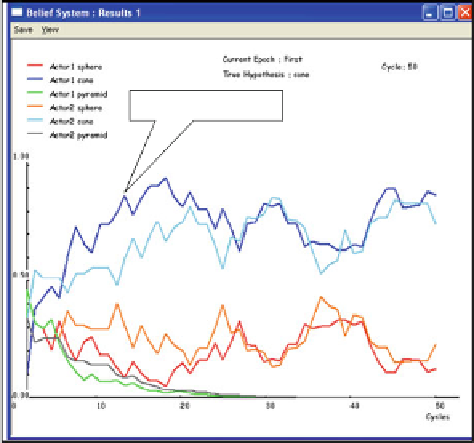Information Technology Reference
In-Depth Information
Fig. 7.5
Two communicating
actors; flexibility 0.3,
receptivity 0.3; 3 hypotheses;
actor 1 negative bias: sphere
0.45, pyramid 0.45, cone 0.1;
actor 2 unbiased; object in
box: cone
ACTOR 1 CONE
ACTOR 2 CONE
As we noted previously, this ensures that simulated experiments can sometimes have
surprising results. This introduction of a random choice of actions based on belief
as a probability is a vital component of the model. This method of action choice
was derived from game theory. Without this option to select apparently irrational
actions the model gets stuck where no further actions are possible. Introducing a
choice based on probability allows fresh paths to be followed and new knowledge to
be gained.
7.6
Evidence-Driven Belief-Revision
Having constructed a computer model based upon the principles described above, in
what follows we show two runs for a single agent. Evidence is the only influence on
belief in this case. A version of the belief model for a PC running Windows
TM
95,
98, ME, 2000, XP or Vista can be downloaded from:
http://www.clarity-support.co.uk/products/belief/index.html
We then compare the belief model with an otherwise identical starting scenario
for two agents in which beliefs are also mediated by the other agent's opinion. This
comparison illustrates how consultation:
1. produces order effects, in that consultation creates greater variability in the
sequence of events and resulting belief-states
2. can also 'smooth' belief-revision.


